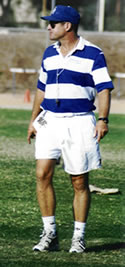 Before
we discuss how to develop
a successful cross country program, we need to determine what
success is. Some might define
success as winning or beating your opponents. However, the talent
you receive will usually determine that. We are not always blessed
with talent every year. So how can you, as a coach, be "successful"
year-in and year-out? The key is focusing on the individual athlete's
potential. This is not an easy task, but it does accomplish two
important objectives:
Before
we discuss how to develop
a successful cross country program, we need to determine what
success is. Some might define
success as winning or beating your opponents. However, the talent
you receive will usually determine that. We are not always blessed
with talent every year. So how can you, as a coach, be "successful"
year-in and year-out? The key is focusing on the individual athlete's
potential. This is not an easy task, but it does accomplish two
important objectives:
1. It allows for more
attainable goals (instead of expecting an athlete to reach levels
that more talented athletes have reached).
2. It provides strategy
that nurtures the critical factors that results in winning (believing
the process is more important).
Win/loss records do
not always measure success. It is your ability to create an environment
so that your athletes can be all that God created them to be.
This should be your foundation.
Now that we understand
what success is, let's move on to the "how" or the practical part
of creating that environment for success.
When you look around
at the programs that are consistently "competitive", you will
find "common threads" that run through all of those programs.
A few of those practices are:
1. Have a plan or "system"
for recruiting. Contacts with junior high and high school physical
education departments, freshman orientation meetings, local youth
programs and track clubs can be very helpful. However, the best
way is the cross country members themselves
encourage their friends to come out. Supply incentives for each
person they recruit like camp discounts, points towards their
varsity letter or special privileges. Note: I tell a kid that
I am recruiting that you always
play. You never have to sit on the bench, and it's also a good
way to meet new friends.
2. Have a strategy
for organizing your team by recruiting good coaching and parent
assistants; plan fundraising; develop a periodization and competition
schedule for team and individual goals; develop regular team trips
(come to Hawaii with us); plan socials (team dinners, BBQ, awards
banquet); communicate regularly with each athlete (a personal
touch) not just handouts or flyers; develop a positive rewards
system. Note: A couple things I specifically do:
- A newsletter explaining
important dates coming up, as well as a list of the top 20 finishers
from every meet.
- Supply free T-shirts
for different events. Runners of the week shirts for outstanding
effort in meets; 500 Club shirts for running 500 miles in a season;
Ralph Club shirts for running so hard you "throw up"; Jalama shirts
for attending summer training camp; or team practice shirts for
completing physical/insurance forms.
- Put on an invitational
in track/cross country or road run. Hopefully something not just
to raise money, but to promote your program too.
3. Develop a program
for promotion by:
-
Maintaining a visible
bulletin board in the hall or locker room.
-
Creating a newsletter
for students, but also parents, teachers, administrators, newspapers
and the community.
-
Posting photos or
show videos of meets and activities.
- Using your classroom
to exhibit pictures, trophies, banners, etc.
Note: I buy extra
practice shirts and give them to teachers, clerical staff, proctors,
custodians, grounds crew, etc. and have everyone wear them on
our meet day.
The key to how
to build your program is the same principle as how you build
a house. You don't frame the house the same way you put on the
roof; you build it in steps. If you are just beginning to build
your cross country program, don't try too many new things at
once. Just try one or two each session. Maybe you can try one
thing from each of the three areas mentioned. If you try to
do too much, it will become overwhelming and very frustrating.
Remember the "building" implies a progression, which takes time.
As you integrate new ideas with your established plans and continue
to focus on your athlete's potential, you will experience cross
country coaching the way it was meant to be.
![]()




